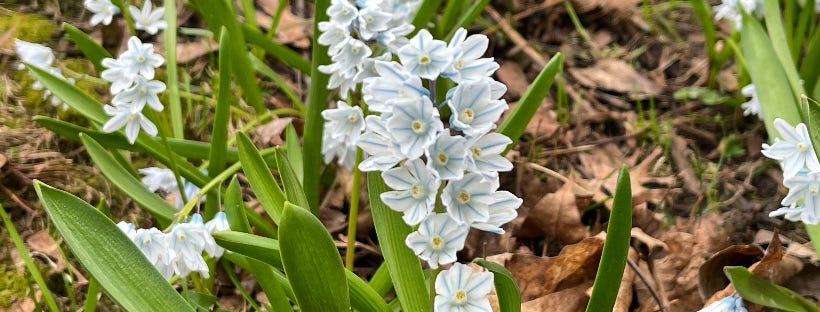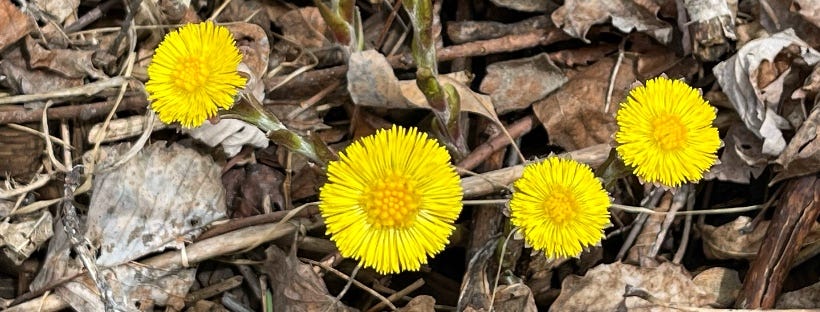I have a bit of a mix for you today: Looking back at the first month of The Planet, then five articles that I think you may like to read on the weekend, and some pictures. I wish you a beautiful Sunday.
Today it is a month ago that I published my first article in this newsletter. I named it 'Welcome to The Planet,' and it is a bit of a mission statement. It was only five days earlier that I first read about Substack and decided to give it a try. Writing that first post was an excellent exercise to develop my initial ideas further. A month into this initiative, it is the right moment to see if The Planet is still on track; these are two quotes from a month ago:
"For a newsletter named 'The Planet,' you may expect me to write about some of the most significant challenges: climate change, biodiversity loss, water, food, energy, and related problems that we have to face on this rapidly changing planet."
And a bit further in the article, I added:
"But if we only look at our planet through the lens of climate change and the loss of nature, we miss an essential part of the story. We often admire anything fragile; we see its beauty and want to protect it. It is also a way of looking at our planet: delicate, beautiful, and in need of protection. I have increasingly changed my focus from the threats to our world to what is at stake. Nowadays, I focus more on the beauty of wildlife, forests, or oceans in my public speaking. Remembering what we risk losing motivates us to preserve all this for the next generation."
I hope you have found both thoughts, the threats and the beauty, in my writings last month. As a way to check this, I just uploaded all articles in a word cloud generator, and this is the result:
I would be interested to hear your thoughts about this word cloud, and more importantly, my writing and the subjects that I cover.
You can find that first post here.
I have a few more thoughts to share about what I wrote a month ago. First on sign-ups for the free emails and paid subscriptions. Many writers on Substack put most of their writing behind the pay-wall while making some posts public to advertise their writing. I prefer to do it another way, although I am not sure if that will work. My approach now is that everyone that likes the newsletter but can't afford it should stay, read everything for free, and enjoy it. The consequence is that those who subscribe to the paid version are not only supporting my work; they also make it possible for the first group to keep reading everything. It makes the subscriptions voluntary support, which I think is a kinder approach that benefits more people. I will keep trying for a while if this works. It all depends on you; I stopped practically all my other work to start this up and am also looking for ways to make this work.
That brings me to a second point. I have heard from several of you that I write too much and should slow down a bit since you can't read it every day. In one of my earlier posts, I said that I commit myself to write a minimum of 100 posts per year. That is an average of two per week, sometimes it will be more, but there will also be moments that I will take a break. Since I started, I published much more than that; I never missed a day. I plan to lower the frequency soon to a more normal level, but I am not sure what that will mean, so let's leave it for now at the earlier commitment of a minimum of hundred per year, and it will likely be significantly more than that. Any thoughts on content, subscriptions, frequency or anything else are always welcome.
Five articles to enjoy during your Sunday morning coffee.
1. How Many Tyrannosaurus Rexes Ever Lived on Earth? Here's a New Clue.
An estimation of the iconic predator's total population can teach us things about dinosaurs that fossils cannot.
2. A brief walk through the history of melting ice
The fourth earl of Minto, Erik the Red, expanding water, the connection between 1942 and 2200, and more in a previous post in The Planet you may have missed.
3. A mysterious photo saves a missing California hiker.
4. 'He's telling a story of his time': how Bill Traylor, born into slavery, became an art titan.
Referred to as 'the greatest artist you've never heard of,' Bill Traylor's compelling life is put under the spotlight in a new documentary.
5. A Man Who Shipped Himself in a Crate Wants to Find the Men Who Helped
Over 50 years after Brian Robson mailed himself out of Australia, emerging almost 8,000 miles away, he is looking for two friends who assisted.
Enjoying spring
Some photos of this week to share that spring feeling.
Don’t forget to subscribe if you want to support this newsletter, or you may want to give a subscription to a friend. Comments are always welcome. Have a great Sunday!










Reading your newsletter is always a wonderful part of my day. The articles are always on topics that I care about and often want to learn more about. Sunday here was a very typical April day: sunshine, cool, cloudy and the sun again. A good day for gardening.
Mahalo nui loa, your daily articles puts me in the here and now, and the future. It makes me think how amazing people can be while I cook breakfast. I forward some of the subjects you write about to buddies on my eMail list with the hopes they will join The Planet newsletter also. The sun is out this Sunday morning, good for the planet and happiness index. (-: